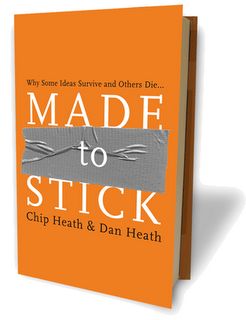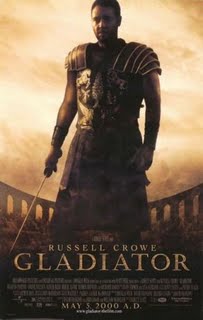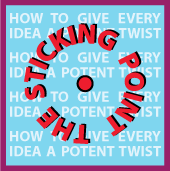Made to Stick: How to Live Forever

* Based upon your feedback, my posts have been getting a bit long. So, I'll split the updates into two. The first will be the context piece from the Book Rapper issue. Then I'll follow this with the update so we're all on the same page.
The Book: Made to Stick
Chip and Dan Heath
Made To Stick: Why Some Ideas Take Hold and Others Come Unstuck
Random House; London; 2007.
The Context: How to Live Forever
Ridley Scott’s Gladiator (2000) depicts the journey of Roman General Maximus Decimus Meridius (played by Russell Crowe) from charismatic war-time army hero, to emotionally bankrupt (Spanish!) slave, to all-conquering Gladiator.
Maximus, with charisma and courage restored, takes on and annihilates his nemesis Emperor Commodus (Joaquin Phoenix).
 The movie is memorable for several reasons, not the least of which is Russ’s riveting Oscar winning performance.
The movie is memorable for several reasons, not the least of which is Russ’s riveting Oscar winning performance.There is also the opening finger-peeping, visceral battle scene in distant Germania, and the scintillating set design of 180 AD Rome.
In one air-sucking scene, barbarian gladiators arrive at the foot of the Coliseum standing agog at the sheer scale of it.
This puts the magnificence of Rome into a useful historical context because it highlights a profound fictional conversation in the movie.
It’s a very short conversation about ten minutes into the film; it’s a conversation that probably went ‘unheard’ by most of the audience.
Marcus Aurelius, the Emperor of Rome (Richard Harris) is talking to Maximus (our Russ). He expresses his concerns over the future of Rome. He starts with the question ‘What is Rome?’ and then says…
“There was once a dream that was Rome. You could only whisper it. Anything more than a whisper and it would vanish, it was so fragile and I fear that it will not survive the winter.”
Two millennium ago, Rome was more than a vibrant city, it was an empire that stretched around the Mediterranean Sea. This was at the heart of Marcus Aurelius’ concern.
Today, the remnants of this Idea are still with us, the physical element is a city paved with history and inhabited by a couple of million people. Yet the cultural legacy lives on in more subtle and more invisible ways.
From today’s standpoint, to imagine Rome as a mere Idea, and one so fragile that it could vanish, is as astonishing as the Coliseum was to the Gladiators.
Rome was – in around 180AD - an Idea!
Just an Idea in the mind and heart of the passionate Emperor of this strife-torn, unstable settlement.
Now, here’s the Point. Doesn’t everything start out as a fragile idea, a mere fleeting thought?
An idea is at the core of everything – yes, everything - that was ever created.
Every man-made concept, conversation or thing started as a fleeting thought in someone’s head.
Yet, the power of Rome, as an idea that has flourished for 2000 years, shows that ideas can be immortal.
 And this, is where Made to Stick finds its place.
And this, is where Made to Stick finds its place.It shows how to take your passing fancy and turn it into your ‘Rome’ – an idea that grows into physical form and can live through the ages – or at least until you’re onto your next project.
How do you take your fleeting fancy and translate it into an Idea that’s long lived, or at least, makes a difference to your here and now?
Sticky Ideas are fundamental to everything we all do.
Business itself is a powerful Idea; an Idea that at some Point in pre-history started as a fanciful thought in someone’s head.
Every minor and major business started in the same way.
Someone had a thought and they framed it in a way that stuck. The raw power of an Idea is it’s potential for immortality.
Can you imagine having an idea that lived forever?
Here’s how...
First you need a thought – a little gem that you think up or, nick from someone else.
Next, you add flesh to your skeletal thought. Until Make It Stick – this may have been hit and miss / pot luck / touch and go. You perform microsurgery on that embryonic Idea to test its core purity – it’s simplicity.
When, and only when, it passes the SUCCESs test, you Innovate (apply it) and give your Idea a life of it’s own in the hearts and minds of others.
We’re all in the business of selling.
Yet, have you ever wondered precisely what it is that you’re selling?
The correct answer is that you’re selling an Idea.
We’re all in the business of Ideas because, ultimately, the idea is what is sold. We don’t buy physical things or strategies or concepts; we buy an Idea. We buy the idea of what that thing can do for us.
Make It Stick could be renamed “How to Sell Ideas”.
Ultimately, that’s what’s up for sale - an Idea - no matter what the product.
We attempt to enrol others into an Idea so that we can move it from its fragile, embryonic state to a more substantial form; a product from which we can profit.
When we set out to sell an Idea, the first sale we need to make is to ourselves.
So, how do you decide if your idea is worth buying? How do you decide if it will work? You trust your gut, because you’re the ultimate consumer; and/or you TWIST your idea because The ‘Will It Stick’ Test works!
Shared Ideas are the building blocks of Life; sound Ideas are the corner stones of our Economy; Sticky Ideas are the mortar of your economic SUCCESs.
What’s your Rome? What’s your big Idea – every day, everywhere - worthy of immortality?
Labels: Chip and Dan Heath, Gladiator, Ideas, Made to Stick

